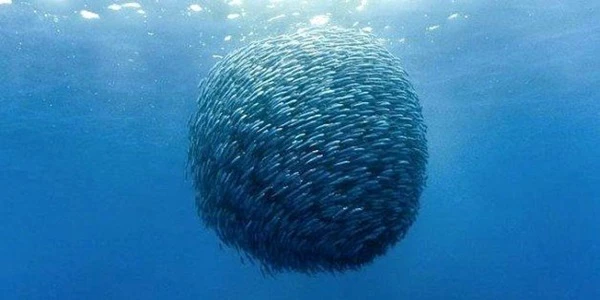More silent than a fish? A school of them
Having more positive emotions as a teen could lead to better health and well-being as an adult / Better mental and physical health among the elderly is associated with nature proximity
With the use of a sophisticated simulation of schooling mackerel, engineers at Johns Hopkins University have produced new research that sheds light on the reasons behind fish schools and holds promise for the development of significantly quieter submarines and autonomous underwater vehicles.
"It's widely known that swimming in groups provides fish with added protection from predators, but we questioned whether it also contributes to reducing their noise," said Rajat Mittal, a senior author. "Our results suggest that the substantial decrease in their acoustic signature when swimming in groups, compared to solo swimming, may indeed be another factor driving the formation of fish schools."

The group generated a three-dimensional (3D) model based on the common mackerel to mimic varying fish populations, their swimming patterns, the proximity of individual fish, and the degree of synchronization between their movements. The model, which works with a variety of fish species, mimics the motion of one to nine mackerel driven forward by their tail fins.
The researchers discovered that a school of fish moving in unison was remarkably successful at reducing noise: a school of seven fish made the same sound as a single fish.
"A predator, such as a shark, may perceive it as hearing a lone fish instead of a group," added Mittal. "This could have significant implications for prey fish."
The team discovered that the synchronization—or rather, lack thereof—of the school's tail flapping was the single most important factor in sound reduction.
Fish that moved simultaneously and flailed their tail fins produced a cumulative sound that did not diminish overall. However, the researchers discovered that the fish cancelled each other out when they alternated in their tail flaps.
"A wave of sound," Mittal declared. If two waves are precisely out of phase with one another, they can cancel each other out or add up. Even though we're talking about very faint sounds that are hardly audible to humans, that's kind of what's occurring here."
Lead author Ji Zhou, a graduate student studying mechanical engineering at Johns Hopkins, explained that in addition to reducing sound, the tail fin movements also create a flow interaction among the fish that enables them to swim faster while consuming less energy.
"We find that reduction in flow-generated noise does not have to come at the expense of performance," Zhou stated. "We found cases where significant reductions in noise are accompanied by noticeable increases in per capita thrust, due to the hydrodynamic interactions between the swimmers."
To their astonishment, the researchers discovered that the benefits of sound reduction begin as soon as a swimming fish joins another. As more fish join a school, the reduction in noise increases, but eventually the team anticipates that the advantages will peak.
"Simply being together and swimming in any manner contributes to reducing the sound signature," added Mittal. "No coordination between the fish is required."
The team's next goal is to incorporate ocean turbulence into the models and produce simulations that let the fish travel more "freely."
Journal Reference: Ji Zhou, Jung-Hee Seo, Rajat Mittal. Effect of schooling on flow generated sounds from carangiform swimmers. Bioinspiration & Biomimetics, 2024; DOI: 10.1088/1748-3190/ad3a4e
End of content
Không có tin nào tiếp theo
